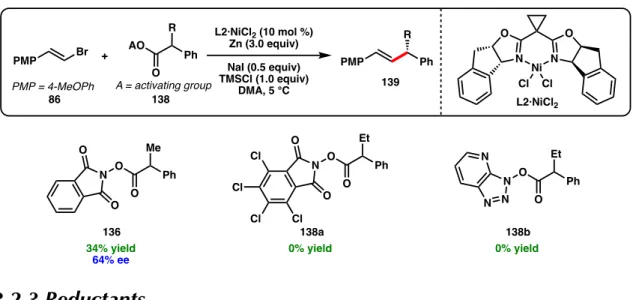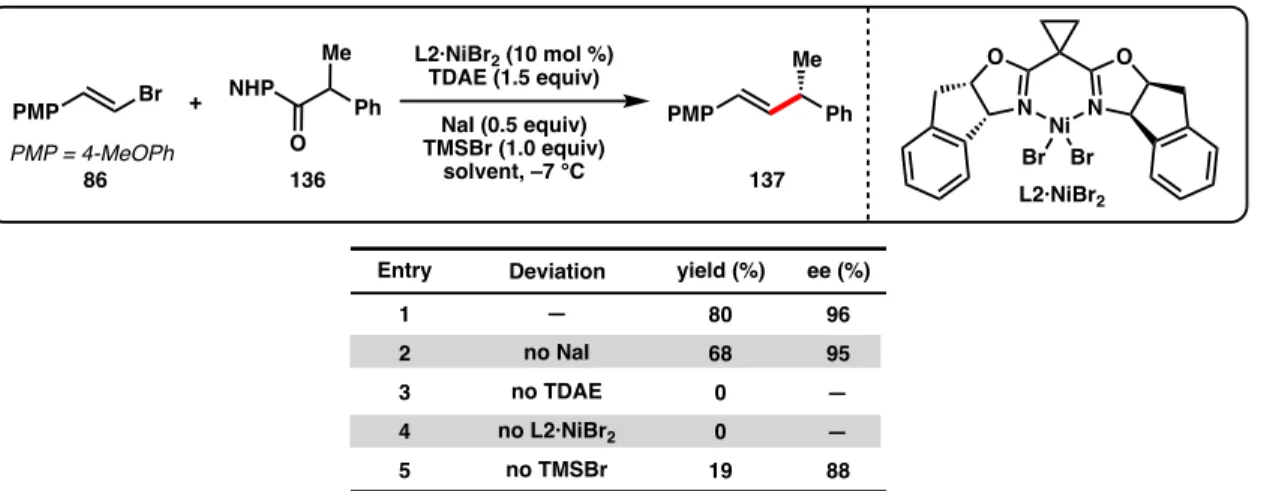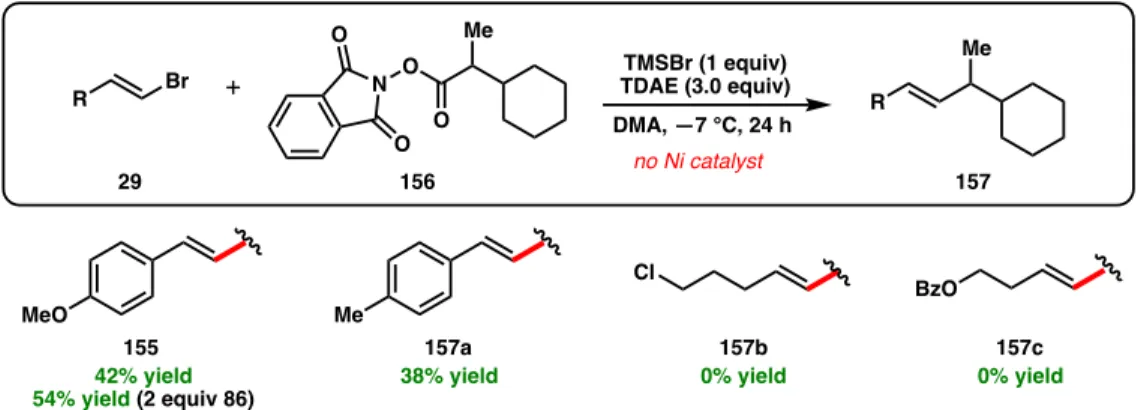As part of our efforts to develop asymmetric cross-coupling reactions employing a variety of C(sp3) electrophiles, we became interested in the coupling of redox-active N-. Alkyl radicals generated from NHP esters can be scavenged by metal catalysts and have recently been used in a number of cross-coupling reactions.49,50 For example, NHP esters have been demonstrated as C(sp3) substrates for Ni-catalyzed Negishi,51 –57. Despite a broad reactivity, NHP esters have not been demonstrated as competent coupling partners in Ni-catalyzed enantioselective cross-coupling reactions.
Here, we report the first Ni-catalyzed asymmetric cross-coupling reactions of NHP esters (Scheme 3.1d). Subjecting NHP ester 136 and alkenyl bromide 86 to our optimal conditions developed for the reductive cross-coupling of alkenyl bromides and benzyl chlorides provided only trace amounts of product (Table 3.1, entry 1).44 The use of Zn as a reductant did not gave improve response (entry 2). A variety of other activated esters have previously been studied in decarboxylative cross-couplings.52 Unfortunately, both the tetrachloro-N-hydroxyphthalimide ester (138a) and the 1-hydroxy-7-azabenzotriazole (HOAt) ester (138b) failed to give none crossed. -the coupling product under the reaction conditions (Figure 3.2).
Although Zn and Mn reductants both showed reactivity to produce 137 when TMSCl was used as an additive, the enantioselectivity was reduced (64% and 90% ee, Table 3.2, entries 1-2) compared to the optimal conditions developed for the cross-coupling of alkenyl bromides and benzyl chlorides (96% ee with L2·NiCl2).44 During our. Weix and colleagues found that, compared to Zn reductants, cross-coupling reactions of aryl iodides with benzyl chlorides using TDAE were more common.
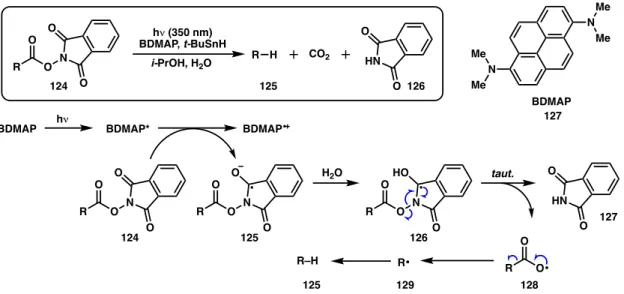
SUBSTRATE SCOPE
It is apparent that alkenyl MIDA boronate 140m and alkenyl silane 140n can be prepared in 97% ee from commercially available vinyl bromides, which can be used as coupling handles for further derivatization. Moreover, dimethyl aniline 141e can be prepared in 66% yield and 94% ee; this compound could not be accessed via our previously reported coupling of benzyl chloride due to challenges in preparing and handling 4-(chloro(phenyl)methyl)-N,N-dimethylaniline according to the standard Figure 3.4 Object of the coupling partner NHP ester. A perfect chemoselectivity for the cross-coupling of the NHP ester over the primary alkyl chloride is observed.
However, several substrates were evaluated that provided the desired cross-linking products in moderate to good yields but with synthetically impermeable ee (Figure 3.5). Although the primary focus of this study was the cross-linking of NHP esters with alkyl substituents at the benzylic position, we also investigated substrates containing heteroatom substitution (Scheme 3.2). This highlights an advantage of the NHP ester for some C(sp3) electrophiles, as the corresponding α-chloroether substrate is unstable and difficult to work with.
For example, NHP esters containing dimethyl amines (147) as well as Boc-protected amines did not form the desired cross-linking products. Since 155 was formed as a racemate, we hypothesized that the cross-coupling reaction was not occurring on Ni, preventing the catalyst from providing any enantioinduction.
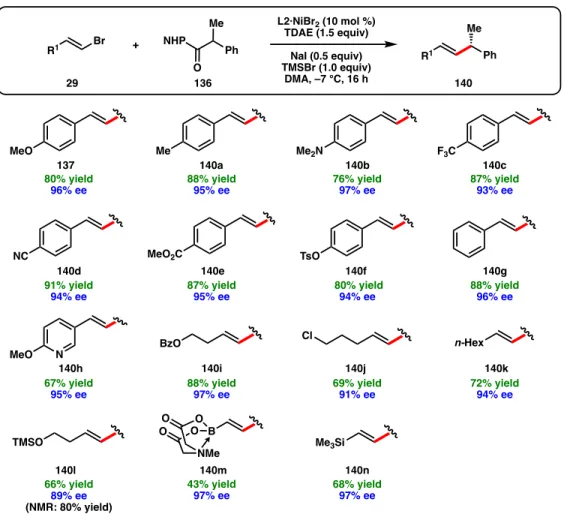
REACTION MECHANISM
While further studies of the reaction mechanism are required, these studies highlight the importance of appropriate substrate selection to avoid intrinsic background reactivity. When the catalyst loading of L2·NiBr2 was varied, the ratio of 161a to total ring-opened product (161b + 161c) was found to increase at higher nickel concentrations (entries 2–3). This Ni-dependent behavior suggests that the mechanism proceeds through a cage-escaped radical which, at higher concentrations of L2·NiBr2, can competitively recombine with nickel before undergoing ring splitting; a radical-chain mechanism may be in effect.70.
Further investigations into the mechanism are underway; it is currently unclear whether the absolute stereochemistry of the cross-coupling product is determined during the oxidative addition or reductive elimination steps.78 However, we note that the products are formed in similar ee when using the NHP esters under the conditions reported here or the benzyl chloride using the previously reported conditions (Figure 3.10).44 The enantioselectivities of 141 were converted to ΔΔG‡ using the reported er and the reaction temperature.

CONCLUSION
EXPERIMENTAL SECTION
Under an inert atmosphere in a glove box, the vial was filled with DMA (0.2 ml, 1.0 M), the reagents were stirred until dissolved, then cooled to the desired temperature. The crude reaction was concentrated to give a thick oil, which was purified by column chromatography (silica, EtOAc/hexane or CH2 Cl2 ) to provide the desired product. The crude residue was purified by filtration through a plug of silica using CH2 Cl2 as eluent to afford 8.7 g (88% yield) of 136 as a white solid.
The crude residue was purified by filtration through a plug of silica with 30% EtOAc/hexane as eluent to give 671 mg (74% yield) of 62a as a white solid. The crude residue was purified by filtration through a plug of silica with 20% EtOAc/hexane as eluent to give 511 mg (48% yield) of 62c as a light yellow solid. The crude residue was purified by filtration through a plug of silica with 20% EtOAc/hexane as eluent to give 590 mg (63% yield) of 62d as a white solid.
The crude residue was purified by column chromatography (silica, 20% EtOAc/hexane) to afford 8.1 g (86% yield) of 62 g as a white solid. The crude residue was purified by column chromatography (silica, 20% EtOAc/hexane) to afford 542 mg (94% yield) over 62 hours as a white solid. The crude residue was purified by filtration through a plug of silica using 20% EtOAc/hexane as eluent to afford.
The crude residue was purified by column chromatography and dried under high vacuum (silica, 0 to 20% EtOAc/hexane) to afford 664 mg (31% yield) of 62j as a colorless oil. The crude residue was purified by filtration through silica eluting with 20% EtOAc/hexane to afford 80 mg (89% yield) of 160 as a white solid. The reaction was removed from the stir plate and slowly added to a vigorously stirred solution of Et2O (150 mL) and hexane (150 mL), filtered through a pad of silica gel, and concentrated under reduced pressure to afford the desired dibromoalkene.
The crude residue was purified by column chromatography (silica, ether/hexanes) to afford vinyl bromide. The crude residue was purified by column chromatography (silica gel, hexane) to give 140 g (37 mg, 88% yield) in 96% ee as a colorless oil. The crude residue was purified by column chromatography (silica gel, hexane) to give 140j (29 mg, 69% yield) in 91% ee as a colorless oil.
The crude residue was purified by column chromatography (silica gel, hexane) to give 140k (31 mg, 72% yield) in 94% ee as a colorless oil. The crude residue was purified by column chromatography (florisil, hexane to 1% Et 2 O/hexane) to give 140 I (33 mg, 66% yield) as a colorless oil. The crude residue was purified by column chromatography (silica gel, hexane) to give 140n (28 mg, 68% yield) in 97% ee as a colorless oil.
The crude residue was purified by column chromatography (silica gel, hexane to 30% toluene/hexane) to afford mixture 161a–c (22 mg, 42% yield) as a colorless oil.
